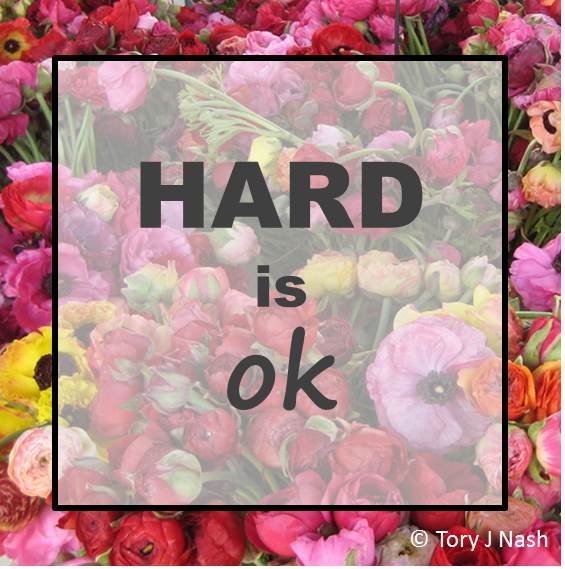I was assisting a yoga class and noticed a very tall gentleman in a very, very short Utthita Trikonasana (triangle pose). I suggested he take a much longer stance given his very long legs. At first he resisted and then he looked worried. That will make the pose too hard he replied. I set him up with some props to bring the floor closer to his hand and he settled into the longer stance.
Several weeks later I suggested a slight modification to someone’s Virabhadrasana II (warrior II pose) to bring the knee in line with the center of the foot. Again I was met with resistance and worry. But it’s so much work to bend my knee and keep it pointing in the right direction was the reply. I smiled and agreed completely. It IS hard. And that’s part of the practice.
Depending on who you are and what particular set of anatomy you came to the practice with it can be hard for a number of reasons. Perhaps your muscles are strong but completely resistant to the idea of stretching. Or perhaps your muscles are very long and the idea of the stability that comes from strong muscles is completely foreign to you. Likely it is some combination of the two.

But you stick with it. You start to explore the physical body and its unique combination of expansiveness and limitations. You push the edges of boundaries both real and imagined. You start to notice your default reaction to the hard. Your mind wanders. It shuts downs. You blame the teacher. You set your jaw and decide to power through as the ego takes over. You make excuses because you aren’t (__________) enough.
And then there is a subtle shift as you start to notice the important difference between needing to let go and come out of the pose because the mind wants a break and the body actually needs a break. You realize you alone control your reaction to this pose and this practice. That it is up to you to learn from this experience and mold it and shape it into something.
It is then that the practice takes a big shift from being all hard, all the time to something more balanced. There is work and effort but there is a lightness and ease. It is both hard and soft. You start to find space for playing and giving it a try no matter what it might end up looking like. And then you forge forward into that next level of exploration – you start to take the yoga off the mat.
You realize all this practice was never about the pose because in the end does a perfect handstand really matter? It was about creating a safe space on the mat to explore our edges and our reactions to life. It was about cultivating a reaction to the hard that life inevitably throws at us. It’s about learning to override the default switches the poses revealed to you. It’s not about instant reactivity but thoughtful consideration. It becomes discernment in action.
Then another shift occurs. You notice you miss the challenge the poses gave you — the way that the hard poses required your instant focus and attention on them. So you start exploring new poses and new variations. You look for ways to continue to hone this skill of being present even when poses are hard. You take that increased learning off the mat, where life continues to throw us something hard or uncomfortable.
And thus the cycle continues: facing what is hard or uncomfortable, working to stay present, finding tremendous growth. This is why hard isn’t to be avoided. It is the place where magic happens. This is why we practice yoga.




Sorry, comments are closed for this post.